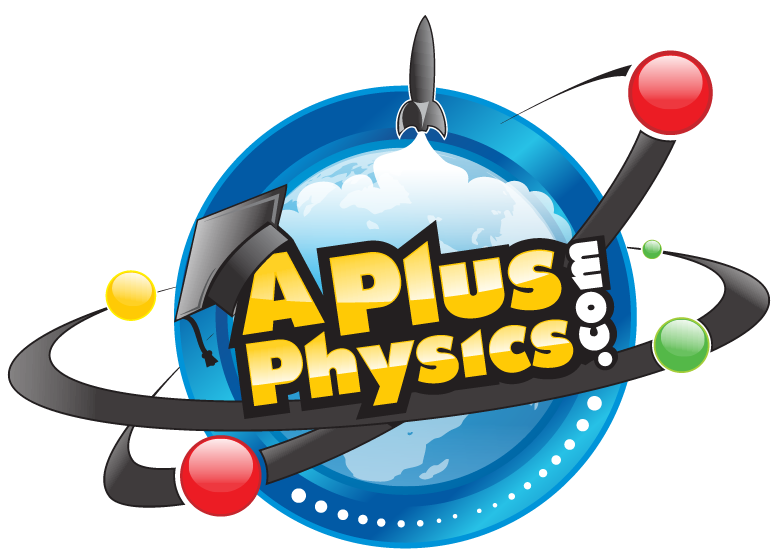Search the Community
Showing results for tags 'power'.
-
Name: AP Physics C: Rotational vs. Linear Review (Mechanics) Category: Rotational Motion Date Added: 2017-04-28 Submitter: Flipping Physics Calculus based review and comparison of the linear and rotational equations which are in the AP Physics C mechanics curriculum. Topics include: displacement, velocity, acceleration, uniformly accelerated motion, uniformly angularly accelerated motion, mass, momentum of inertia, kinetic energy, Newton’s second law, force, torque, power, and momentum. Want Lecture Notes? Content Times: 0:12 Displacement 038 Velocity 1:08 Acceleration 1:33 Uniformly Accelerated Motion 2:15 Uniformly Angularly Accelerated Motion 2:34 Mass 3:19 Kinetic Energy 3:44 Newton’s Second Law 4:18 Force and Torque 5:12 Power 5:45 Momentum Multilingual? Please help translate Flipping Physics videos! AP Physics C Review Website Next Video: AP Physics C: Universal Gravitation Review (Mechanics) Previous Video: AP Physics C: Rotational Dynamics Review - 2 of 2 (Mechanics) Please support me on Patreon! Thank you to Sawdog for being my Quality Control individual for this video. AP Physics C: Rotational vs. Linear Review (Mechanics)
-
Name: AP Physics C: Work, Energy, and Power Review (Mechanics) Category: Work Energy & Power Date Added: 2017-03-30 Submitter: Flipping Physics Calculus based review of work done by constant and non-constant forces, Hooke’s Law, Work and Energy equations in isolated and non-isolated systems, kinetic energy, gravitational potential energy, elastic potential energy, conservative vs. nonconservative forces, conservation of mechanical energy, power, neutral, stable, and unstable equilibrium. For the calculus based AP Physics C mechanics exam. Want Lecture Notes? Content Times: 0:11 Work done by a constant force 2:25 Work done by a non-constant force 3:58 Force of a Spring (Hooke’s Law) 4:52 Calculating the work done by the force of a spring 6:26 Net work equals change in kinetic energy 7:02 Gravitational Potential Energy 7:50 Non-isolated systems work and energy 8:29 Isolated systems work and energy 9:02 Conservative vs. Nonconservative forces 10:10 Conservation of Mechanical Energy 10:45 Power 12:09 Every derivative can be an integral 13:00 Conservative forces and potential energy 13:46 Deriving Hooke’s Law from elastic potential energy 14:22 Deriving the force of gravity from gravitational potential energy 15:17 Neutral, stable, and unstable equilibrium Multilingual? Please help translate Flipping Physics videos! AP Physics C Review Website Next Video: AP Physics C: Integrals in Kinematics Review (Mechanics) Previous Video: AP Physics C: Dynamics Review (Mechanics) Please support me on Patreon! Thank you to Aarti Sangwan for being my Quality Control help. AP Physics C: Work, Energy, and Power Review (Mechanics)
-
- unstable equilibrium
- stable equilibrium
-
(and 17 more)
Tagged with:
- unstable equilibrium
- stable equilibrium
- work
- neutral equilibrium
- constant force
- non-constant force
- hookes law
- net work
- spring
- kinetic energy
- gravitational potential energy
- elastic potential energy
- isolated system
- potential energy
- non-isolated system
- conservative force
- nonconservative force
- conservation of energy
- power
-
Name: Instantaneous Power Delivered by a Car Engine - Example Problem Category: Work, Energy, Power Date Added: 2017-01-12 Submitter: Flipping Physics A Toyota Prius is traveling at a constant velocity of 113 km/hr. If an average force of drag of 3.0 x 10^2 N acts on the car, what is the power developed by the engine in horsepower? Want Lecture Notes? This is an AP Physics 1 Topic. Content Times: 0:15 The problem 1:18 Which equation to use and why 2:20 Billy solves the problem 3:59 What if the car is moving at 129 km/hr? Next Video: You Can't Run From Momentum! (a momentum introduction) Multilingual? Please help translate Flipping Physics videos! Previous Video: Average Power Delivered by a Car Engine - Example Problem Please support me on Patreon! Instantaneous Power Delivered by a Car Engine - Example Problem
-
- instantaneous
- power
-
(and 6 more)
Tagged with:
-
Name: Average Power Delivered by a Car Engine - Example Problem Category: Work, Energy, Power Date Added: 2016-07-28 Submitter: Flipping Physics A 1400 kg Prius uniformly accelerates from rest to 30 km/hr in 9.25 seconds and 42 meters. If an average force of drag of 8.0 N acts on the car, what is the average power developed by the engine in horsepower? Want Lecture Notes? This is an AP Physics 1 Topic. Content Times: 0:15 Translating the example to physics 2:13 The equation for power 3:37 Drawing the Free Body Diagram and summing the forces 4:47 Solving for acceleration and Force Applied 5:43 Determining theta 6:01 Solving for Average Power 6:53 Understanding our answer 7:34 The Horse Pedal 9:13 Comparing to a larger acceleration example Next Video: Instantaneous Power Delivered by a Car Engine - Example Problem Multilingual? Please help translate Flipping Physics videos! Previous Video: Graphing Instantaneous Power Please support me on Patreon! Average Power Delivered by a Car Engine - Example Problem
-
Name: Graphing Instantaneous Power Category: Work, Energy, Power Date Added: 2016-06-28 Submitter: Flipping Physics An 8.53 kg pumpkin is dropped from a height of 8.91 m. Will the graph of instantaneous power delivered by the force of gravity as a function of _____ be linear? If not, what would you change to make the graph linear? (a) Time, (b) Position. Want Lecture Notes? This is an AP Physics 1 Topic. Content Times: 0:12 The example 1:08 The equation for instantaneous power 1:43 Part (a): Solving for velocity as a function of time 2:55 Part (a): Solving for power as a function of time 3:23 Part (a): Is power as a function of time linear? 4:26 Part (a): Graphing power as a function of time 5:03 Part (b): Solving for velocity as a function of position 5:58 Part (b): Solving for power as a function of position 7:02 Part (b): Is power as a function of position linear? 7:38 Part (b): How can we make the graph linear? 8:33 Part (b): Graphing power squared as a function of position Next Video: Average Power Delivered by a Car Engine - Example Problem Multilingual? Please help translate Flipping Physics videos! Previous Video: Average and Instantaneous Power Example Please support me on Patreon! Graphing Instantaneous Power
-
Name: Average and Instantaneous Power Example Category: Work, Energy, Power Date Added: 2016-06-02 Submitter: Flipping Physics An 8.53 kg pumpkin is dropped from a height of 8.91 m. What is the power delivered by the force of gravity (a) over the whole displacement of the pumpkin, (b) right after the pumpkin is dropped and (c) right before the pumpkin strikes the ground? Want Lecture Notes? This is an AP Physics 1 Topic. Content Times: 0:16 The example 1:26 Visualizing the example 2:22 Part (a) 3:32 Solving for Δt 5:32 Alternate solution to part (a) 6:33 Average vs. Instantaneous Power Equations 7:45 Part (b) 8:12 Part (c) Next Video: Graphing Instantaneous Power Multilingual? Please help translate Flipping Physics videos! Previous Video: Introduction to Power Please support me on Patreon! Average and Instantaneous Power Example
-
Name: Introduction to Power Category: Work, Energy, Power Date Added: 2016-05-21 Submitter: Flipping Physics Mr.P introduces power which equals work divided by change in time and it also equals force times velocity times cosine theta. Want Lecture Notes? This is an AP Physics 1 Topic. Content Times: 0:12 The difference between the two examples 0:43 The definition of power 1:04 Why the work is the same in both examples 2:13 Which example has more power 2:45 The units for power; watts 3:33 The other equation for power 4:46 Horsepower Next Video: Average and Instantaneous Power Example Previous Video: Net Work equals Change in Kinetic Energy Problem by Billy Multilingual? Please help translate Flipping Physics videos! Are you learning from my videos? Please support me on Patreon! Introduction to Power
-
- introduction
- watts
-
(and 5 more)
Tagged with:
-
Everybody loves a good hero. But, are they realistic? Some of our favorite crusaders - Batman, Link, Green Arrow - use grappling hooks to get around. I wonder if they’d work like in the games and movies. Let’s say Batman is trying to get into Arkham Asylum to teach some no good-nicks what he thinks of this whole “rehabilitation” thing. He needs to get two floors up, which is about 6.6 m. And, like in the movies, he needs to rocket up that distance, let’s say at about 6 m/s. The average man weighs 70 kg, but Batman is pretty buff, so we’ll make it 75 kg. We can calculate the work needed to be (.5)mv^2 + mgh, which here equals 6205.95 J. We also know v = d/t, so that means t = d/v = 1.1 s. And, power = W/t = 5641.77 W. It’s pretty safe to say a handheld motor like the ones we see in the media couldn’t make over 5.5 kW of pull. A mounted artillery grappling gun could, and are used by the US special forces for stealth missions. However, until our technology evolves a bit more, Batman will just have to learn to actually fly.
-
- grappling hook
- energy
-
(and 2 more)
Tagged with:
-
Name: Work, Energy and Power Review for AP Physics 1 Category: Exam Prep Date Added: 13 March 2015 - 08:25 AM Submitter: Flipping Physics Short Description: None Provided Review of the topics of Work, Energy, Power and Hooke’s Law covered in the AP Physics 1 curriculum. Content Times: 0:18 Work 1:38 Kinetic Energy 2:13 Elastic Potential Energy 3:02 Gravitational Potential Energy 4:02 Work and Energy are in Joules 4:58 Conservation of Mechanical Energy 5:54 Work due to Friction equals the Change in Mechanical Energy 6:46 Power 7:46 Hooke’s Law Multilingual? View Video
-
- conservation
- mechanical
-
(and 8 more)
Tagged with:
-
Hello! I'm using the "AP Physics Essentials: 1" book to study for my Work, Power, and Energy exam (chapter 5.) I need clarification on question 5.10; how do we decide on the equation to use? I'm so lost on how to make that determination. Thanks!
-
Terms of Use
The pages of APlusPhysics.com, Physics in Action podcasts, and other online media at this site are made available as a service to physics students, instructors, and others. Their use is encouraged and is free of charge. Teachers who wish to use materials either in a classroom demonstration format or as part of an interactive activity/lesson are granted permission (and encouraged) to do so. Linking to information on this site is allowed and encouraged, but content from APlusPhysics may not be made available elsewhere on the Internet without the author's written permission.
Copyright Notice
APlusPhysics.com, Silly Beagle Productions and Physics In Action materials are copyright protected and the author restricts their use to online usage through a live internet connection. Any downloading of files to other storage devices (hard drives, web servers, school servers, CDs, etc.) with the exception of Physics In Action podcast episodes is prohibited. The use of images, text and animations in other projects (including non-profit endeavors) is also prohibited. Requests for permission to use such material on other projects may be submitted in writing to info@aplusphysics.com. Licensing of the content of APlusPhysics.com for other uses may be considered in the future.


